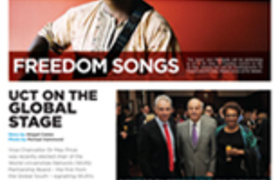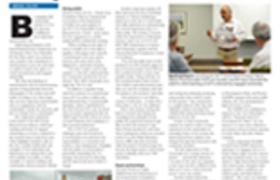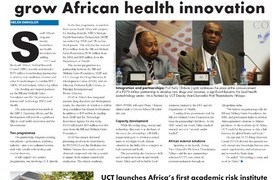Citizen scientists: The power of small numbers
17 June 2014The Kalahari plated lizard (Gerrhosaurus multilineatus), featured in the recently launched Reptile Atlas, lives in holes between roots of shrubs in the bushveld and Kalahari sandveld of Namibia. Until recently it had never been photographed. But thanks to the efforts of citizen scientists, there's now a visual record of this handsome lizard.
Public participation is being harnessed by the Animal Demography Unit (ADU), co-ordinators of the Reptile Atlas, to provide a reach far beyond formal fieldwork. Such is the power of the humble citizen scientist.
"[Citizen scientist] contributions are invaluable," says ADU director Emeritus Professor Les Underhill. "The wealth of data and information contributed by these people, collated and curated at the ADU, and analysed by its students and staff, has greatly improved biodiversity conservation in Southern Africa."
Detailed reports of reptile finds, with photographs and GPS co-ordinates, stream in to the ADU's Virtual Museum (vmus.adu.org.za) – and each is identified by a panel of experts. These records not only provide information on species distribution, but also yield useful information on rare species.
In April, citizen scientist Laurenda van Breda submitted a report and photograph of a black percher (Diplacodes lefebvrii), a tiny dragonfly she'd spotted at the Cape Flats Nature Reserve. Experts confirmed that her find is not only very rare in the Western Cape, but also that the black percher had never before been recorded on the Cape Peninsula – the few records for this species range from Citrusdal to East London.
The data went straight into the Virtual Museum.
The growth in public participation has been spurred by developments in digital photography and GPS units, which have revolutionised data collection and made virtual museums possible.
Now, anyone with a digital camera can become a citizen scientist.
"They help us fill in a lot of gaps," says Underhill.
"By becoming involved in these projects, people learn an enormous amount about the natural world," says ADU postdoctoral research fellow Sally Hofmeyr, whose interest is science communication. "One of the ways I've participated is by recording a bird list every time I walk from my flat to UCT."
Around 1 360 citizen scientists contributed to the South African Bird Atlas Project 2 (SABAP2) database. Of these, 43 submitted 500 or more checklists, at least one every five days since the project began. Collectively, they've submitted 37 000 checklists, some 37% of SABAP2's database. The impetus has taken the ADU's Virtual Museum to a new milestone: 80 000 entries.
Hofmeyr is investigating the role of translational research communication, looking at the backend of the ADU's Facebook page: who reads it, how it engages people, and how far-reaching the data is.
Keen to build exposure to science at the critical school levels, Hofmeyr is also working with transmedia education publishers Siyavula (whose online textbooks are free to download as open education resources), to get citizen science material into their books. The idea is to grow citizen scientists early.
Story by Helen Swingler.
 This work is licensed under a Creative Commons Attribution-NoDerivatives 4.0 International License.
This work is licensed under a Creative Commons Attribution-NoDerivatives 4.0 International License.
Please view the republishing articles page for more information.
News
Faculty Focus - Humanities
Opinions
Photo Essay
Front page
Previous Editions










